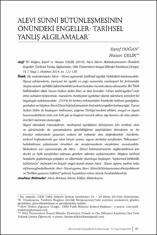| dc.contributor.author | Doğan, Eşref | |
| dc.contributor.author | Çelik, Hasan | |
| dc.date.accessioned | 2019-10-15T06:12:08Z | |
| dc.date.available | 2019-10-15T06:12:08Z | |
| dc.date.issued | 2014 | |
| dc.identifier.citation | Doğan, E., Çelik, H. (2014). Alevi Sünni bütünleşmesinin önündeki engeller: Tarihsel yanlış algılamalar. Hitit Üniversitesi Sosyal Bilimler Enstitüsü Dergisi,
7(1), 121-138. | en_US |
| dc.identifier.issn | 1308-5107 | |
| dc.identifier.uri | https://hdl.handle.net/11491/4287 | en_US |
| dc.identifier.uri | https://doi.org/10.17218/husbed.15009 | en_US |
| dc.description | research | en_US |
| dc.description.abstract | Bu makalemizde; Alevi – Sünni ayrımın ın tarihsel ayrılık noktaları irdelenecektir. Siyasi çekişmelerin, inançsal bir ayrılık ve çoğu zamanda mezhepsel bir farkındalık oluşturulacak şekilde işlenmesinin tarihsel hataları mercek altına alınacaktır. İki Türk hükümdarı olan Yavuz Sultan Selim Han ve Şah İsmail›in “cihan hâkimiyetini” elde etme çabaları neticesinde, inançların mezhepsel ayrılıklar olarak işlenmesi süreçleri bir boyutuyla açıklanacaktır. 1514’te ki kırılma noktasından hareketle tarihsel yanılgıları, yanlışları ve böylece Alevi-Sünni bütünleşmesinin önündeki engelleri tartışacağız. Yavuz Sultan Selim ile başlayan kırılmanın, çağımız Türkiye’sindeki etkileri, sosyal ve siyasi huzursuzluklarla dolu son kırk yılı ve bugünü mercek altına alıp kısmen de olsa çözüm önerileri üzerinde duracağız. Siyasi alandaki mücadelenin, mezhepsel ayrılıklara dönüşmesi için verilmiş olan ve günümüzde de yansımalarını görebildiğimiz ş eyhülislam fetvalarını ve bu fetvalar neticesinde yaşanan acılara bir nebzede olsa değinilecektir. Alevilerin, tarihsel hafızalarında yer alan birçok acının, siyasi otoriteler tarafından “bilinçsizce” hatırlatılması çabalarının örnekleri siz araştırmacıların eleştirisine sunulacaktır. Makalenin son aşamasında da Alevi – Sünni bütünleşmesinin sağlanabilmesi için devlet ve halk tarafından atılması gereken adımlar açıklanacaktır. Böylece tarihsel hatalarla yoğrulmaya çalışılan ve ülkemizde oluşmaya başlayan “toplumsal birliktelik kültürünün” önündeki en büyük engel olarak duran Alevi - Sünni ayrımı, tarihin tozlu raflarına gönderilecektir. Alevi - Sünni ayrımı, Alevi - Sünni bütünleşmesine dönüşebilecek ve “birlikte yaşama kültürü” gelecek kuşaklara miras olarak bırakılabilecektir. | en_US |
| dc.description.abstract | In this article, the Alevi/Sunni historical point of distinct separation will be discussed. Political wrangling, and religious sectarian differences, which are often manipulated to create an awareness of historical errors, will be analyzed. Two Turkish rulers, Sultan Selim Khan and Shah Ismail, who sought to achieve “world domination” as a result of their efforts, their beliefs as well as sectarian differences, will be explained in a dimension of the handling process. Starting from 1514, which was the breaking point of historical misconceptions and falsehoods and thus the integration of the Alevi-Sunni will be discussed, including the obstacles as well. Starting with the rupture of Yavuz Sultan Selim, and the effects in Turkey in our age, which are full of social and political unrest during the past forty years as well as today, are partly under the spotlight in this report. In addition to this, we will concentrate on the solutions as well. The struggles in the political field, which can turn into sectarian differences, we can see today in the reflections of the fatwa of Shaykh al-Islam and the sorrow created as a result of these fatwas, which will be referred to later on. Alavi, which is located in the historical memory of a very painful past, examples are given “unconsciously” by the political authorities of their efforts, to remind the critics of researchers of what will be presented to them. The articles found in the final stages of the Alevi/Sunni historical point of distinct separation are used in order to ensure that steps of integration be taken by the public will be explained in this paper. There is a mix of historical errors and, to make the situation worse, “a culture of social cohesion” is beginning to form in our country, making it the biggest obstacle currently standing in front of the Alevi/Sunni distinction, and one which will be sent to the dustbin of history. The Alevi/Sunni distinction and the Alevi/Sunni integration can be transformed into a culture that “lives together” peacefully, which can be left as a legacy to future generations. | en_US |
| dc.language.iso | tur | en_US |
| dc.relation.isversionof | 10.17218/husbed.15009 | en_US |
| dc.rights | [Belirlenecek] | en_US |
| dc.subject | Alevi | en_US |
| dc.subject | Bektaşi | en_US |
| dc.subject | Sünni | en_US |
| dc.subject | Kültür | en_US |
| dc.subject | Bütünleşme | en_US |
| dc.title | Alevi Sünni bütünleşmesinin önündeki engeller: Tarihsel yanlış algılamalar | en_US |
| dc.title.alternative | The obstacles to the Integration of Alevi - Sunni: The historical misperceptions | en_US |
| dc.type | article | en_US |
| dc.relation.journal | Hitit Üniversitesi Sosyal Bilimler Enstitüsü Dergisi | en_US |
| dc.department | Hitit Üniversitesi, İlahiyat Fakültesi, Felsefe ve Din Bilimleri Bölümü | en_US |
| dc.identifier.volume | 7 | en_US |
| dc.identifier.issue | 1 | en_US |
| dc.identifier.startpage | 121 | en_US |
| dc.identifier.endpage | 138 | en_US |
| dc.relation.publicationcategory | [Belirlenecek] | en_US |


















